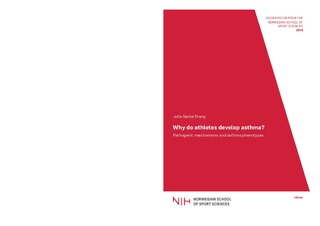| dc.contributor.author | Stang, Julie | |
| dc.date.accessioned | 2018-03-16T09:15:11Z | |
| dc.date.available | 2018-03-16T09:15:11Z | |
| dc.date.issued | 2018 | |
| dc.identifier.isbn | 978-82-502-0549-9 | |
| dc.identifier.uri | http://hdl.handle.net/11250/2490794 | |
| dc.description | Avhandling (doktorgrad) - Norges idrettshøgskole, 2018 | nb_NO |
| dc.description.abstract | Background: Asthma is reported frequently in endurance athletes, particularly among swimmers and cross-country skiers. However, the mechanisms of asthma development in athletes are not fully understood, and they seem to differ from the mechanisms reported in non-athletes. Highintensity endurance exercise accompanied by high ventilation rates (VE) combined with unfavourable environmental exposures, such as exposure to chlorinated swimming pools or cold, dry air, is reported to induce epithelial damage in the airways. However, current evidence is not complete concerning the relationships between airway inflammation, systematic endurance exercise and bronchial hyperresponsiveness (BHR). Furthermore, the influence of other physiological adaptations to endurance exercise is not clear. In addition, sports asthma has been proposed as a specific phenotype of asthma, but this hypothesis has not yet been verified. The physiological adaptations to endurance exercise include the autonomic nervous system, which mediates the contraction and relaxation of bronchial smooth muscle, with cholinergicparasympathetic nerves stimulating bronchoconstriction. Parasympathetic activity is reported to be increased in endurance athletes and to correlate with maximal oxygen uptake (VO2max). As BHR denotes an increased bronchoconstrictor response to different stimuli (such as cold air, exercise or pharmacologic substances), increased parasympathetic activity in athletes could also increase the bronchomotor tone and the susceptibility to bronchospasm and thus BHR. In this regard, the measurement of parasympathetic activity in athletes with asthma may be of clinical value for better understanding the development of asthma in athletes. However, it remains unknown how different measurement procedures vary in terms of target organ. Objectives: The present thesis aimed to investigate the pathogenic mechanisms of asthma in athletes, with an emphasis on the roles of the parasympathetic nervous system and airway inflammation in BHR, as well as asthma phenotypes. Swimmers and cross-country skiers were specifically targeted due to the high prevalence of asthma and BHR reported in the literature. | nb_NO |
| dc.description.abstract | Paper I: Stang J, Stensrud T, Mowinckel P, Carlsen KH. Parasympathetic activity and bronchial hyperresponsiveness in athletes. Med Sci Sports Exerc. 2016;48(11):2100-2107. | |
| dc.description.abstract | Paper II: Stang J, Sikkeland, LIB, Tufvesson E, Holm A, Stensrud T, Carlsen KH. The role of airway inflammation and bronchial hyperresponsiveness in athlete's asthma. Manuscript accepted for publication in Med Sci Sports Exerc. | |
| dc.description.abstract | Paper III: Couto M, Stang J, Horta L, Stensrud T, Severo M, Mowinckel P, Moreira A, Carlsen KH. Two distinct phenotypes of asthma in elite athletes identified by latent class analysis. J Asthma. 2015;52(9):897-904. | |
| dc.language.iso | eng | nb_NO |
| dc.subject | nih | nb_NO |
| dc.subject | doktoravhandlinger | nb_NO |
| dc.subject | astma | |
| dc.subject | idrett | |
| dc.subject | utøvere | |
| dc.subject | svømming | |
| dc.subject | langrenn | |
| dc.title | Why do athletes develop asthma?: Pathogenic mechanisms and asthma phenotypes | nb_NO |
| dc.type | Doctoral thesis | nb_NO |
| dc.description.localcode | Seksjon for idrettsmedisinske fag / Department of Sport Medicine | nb_NO |
